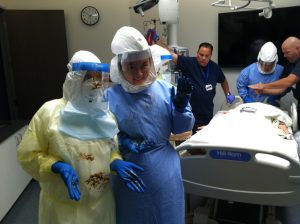The largest patient movement exercise in U.S. Department of Health and Human Services’ history began 4/10/18 to test the nationwide ability to move patients with highly infectious diseases safely and securely to regional treatment centers.
April 12th, 2018HHS sponsors its largest exercise for moving patients with highly infectious diseases
The largest patient movement exercise in U.S. Department of Health and Human Services’ history began today to test the nationwide ability to move patients with highly infectious diseases safely and securely to regional treatment centers.
“Saving lives during crises requires preparation and training,” explained HHS Assistant Secretary for Preparedness and Response Robert Kadlec, M.D. “A tremendous amount of coordination, synchronization, and skill is needed to move patients with highly infectious diseases safely. We have to protect the patients and the healthcare workers caring for those patients. This type of exercise helps ensure that everyone involved is ready for that level of complexity.”
Coordinated by the HHS Office of the Assistant Secretary for Preparedness and Response, more than 50 organizations will participate, including the Department of State, Department of Transportation, the Regional Ebola Treatment Centers, local and state health and emergency management agencies, hospitals, airport authorities, and non-government organizations.
Throughout the exercise, participants react as if the incident is real. They must take the necessary actions and employ the appropriate resources to manage and protect the patients, the workforce and the environment and safely transport the patients.
The exercise focuses on moving seven people acting as patients with Ebola symptoms in different regions of the country. The patients, including one pediatric patient, first present themselves at one of the following healthcare facilities: CHI St. Luke’s Health-The Woodlands Hospital in The Woodlands, Texas; Medical University of South Carolina in Charleston, South Carolina; Norman Regional Hospital in Norman, Oklahoma; St. Alphonsus Regional Medical Center in Boise, Idaho, and St. Luke’s Regional Medical Center in Boise, Idaho.
At each facility, healthcare workers will collect and ship samples for diagnostic tests to state laboratories, which in turn will practice running the necessary laboratory tests to diagnose the patients with Ebola. As part of the exercise, each patient will receive a positive diagnosis. Using appropriate isolation techniques and personal protective equipment, health care workers then must take steps to have six of the patients transported by air to designated Regional Ebola Treatment Centers. These patients will be placed into mobile biocontainment units for these flights. The pediatric patient will be placed into protective equipment and transported by ground ambulance.
The treatment centers that will receive the patients are Cedars-Sinai Medical Center in Los Angeles, California; Emory University Hospital in Atlanta, Georgia; Providence Sacred Heart Medical Center in Spokane, Washington; and University of Texas Medical Branch in Galveston, Texas. The pediatric patient will be transported to Texas Children’s Hospital West Campus in Houston, Texas.
The participating airports are Boise Airport in Boise, Idaho; Charleston International Airport in Charleston, South Carolina; DeKalb-Peachtree Airport in Atlanta, Georgia; Ellington Field Airport in Houston, Texas; Los Angeles International Airport in Los Angeles, California; Spokane International Airport in Spokane, Washington; and Will Rogers World Airport in Oklahoma City, Oklahoma. Upon arrival, local emergency responders will transfer the patients to ground ambulances for transportation from the airports to the treatment centers.
HHS and the Department of State previously collaborated on exercises to move Americans acting as Ebola patients from West African countries to Ebola treatment centers in the United States. In public health emergencies or disasters, the U.S. government orchestrates the return of Americans to the United States, including Americans who are sick or injured.
This exercise runs through April 12. Participants will gather on April 13 to assess the exercise, compare actions across the country, and share best practices for moving patients with highly infectious diseases.
Note to editors: Video sound bites from Dr. Kadlec are available for download at https://www.dropbox.com/sh/ktvdv44y7z68ly7/AAAf2H_JzzY8i-tzREY6VfaAa?dl=0 ![]() .
.


